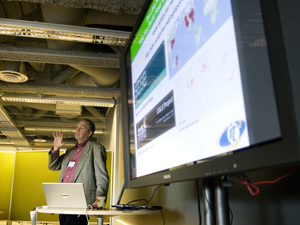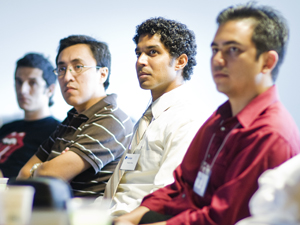Global Cyberbridges Workshop Unites FIU, UCSD In Quest For Greener Computing
By Tiffany Fox, (858) 246-0353, tfox@ucsd.edu
San Diego, CA, July 17, 2009 — A group of Florida International University (FIU) graduate students representing more than 10 nations and a dozen academic disciplines gathered at the University of California, San Diego earlier this month to learn more about UC San Diego's GreenLight Project, an effort to connect scientists and their labs to more energy-efficient "green" computing and storage systems.
|
The students visited the California Institute for Telecommunications and Information Technology (Calit2) at UCSD as part of FIU's Global CyberBridges program. The program, as described by Director Heidi Alvarez, is a means of creating "a new generation of scientists and engineers who are capable of fully integrating cyberinfrastructure (CI) into the whole educational, professional, and creative process of diverse disciplines."
"Normally those students would not encounter each other at the Ph.D. level, so one goal is to bring all these different disciplines together," added Alvarez. "We also asked our students to present their research projects in the hope that some of the CI researchers from Calit2 would look at what they're doing and come up with some ideas about how those projects could fit into the realm of GreenLight and energy-efficient computing."
The Global CyberBridges program was created at FIU in 2005, when four fellows in physics, chemistry and bioengineering were selected to enroll in an experimental course that focused on high-performance networking and cluster computing. The program has since expanded to include a total of 34 students from a number of disciplines — including finance, electrical and mechanical engineering, earth and biosciences and computer science — and collaborations with the Chinese Academy of Science, the University of Sao Paulo and UC San Diego.
In addition to its alliance with the GreenLight Project, the CyberBridges program has formed a partnership with UC San Diego's OptIPuter project, building an OptIPortal visualization cluster that can be deployed on a variety of hardware platforms and can be used for videoconferencing and other remote collaboration, thereby reducing the need for energy-consumptive air and motor transport.
|
"Global CyberBridges has shown that when a faculty member enters into a partnership with a graduate student and a CI research scientist, the results are compelling," noted Alvarez. "We define a metric of success as publication in peer-reviewed journals or at conferences, and to date, students, faculty and staff have collaborated on 21 peer-reviewed publications. Summer internships and job offers are also measured, and we have very good results there.
"CyberBridges is impacting the faculty doing research and teaching today, and the faculty of the future."
The Global CyberBridges workshop at Calit2 was also the kick-off event for a push to broaden the impact of the GreenLight Instrument award, which was awarded to UC San Diego by the National Science Foundation. Calit2's Thomas DeFanti, principal investigator for GreenLight, praised the presentations by UCSD GreenLight researchers Rajesh Gupta, Amin Vahdat, Ingolf Krueger, Jurgen Schulz and Greg Hidley, as well as UCSD Graphics Processing Unit expert Raj Singh. Their presentation topics included "A Scalable Data Center Switch Architecture" and "Aggressive Dutycycling for Energy Efficient Computing."
"Telepresence is consumptive of energy and expensive," DeFanti remarked. "If we're going to use computing to do better collaboration, it better be greener as well. The excellent presentations at the Global CyberBridges project set the bar high for future get-togethers. Next time we will allocate much more time for questions — there were so many excellent ones that sparked discussions during the evening and next day's events."
|
The students who attended the workshop were similarly impressed. Eighty percent of the attendees at the workshop reported that the presentations exceeded their expectations, and 19 percent said their expectations were met (1 percent was "undecided"). One student remarked that the workshop was of the "highest quality" and provided an "excellent opportunity to observe emerging technologies that rely on supercomputing techniques."
Another student said the event was a "delightful experience" that "helped me understand the 'California state-of-mind,' where there are no limits to the human dreams."
Added a third: "I look forward to attending and presenting at future workshops as I advance toward a professorship and my own research with applied cyberinfrastructure and green technology."
Media Contacts
Tiffany Fox, (858) 246-0353, tfox@ucsd.edu
Related Links




